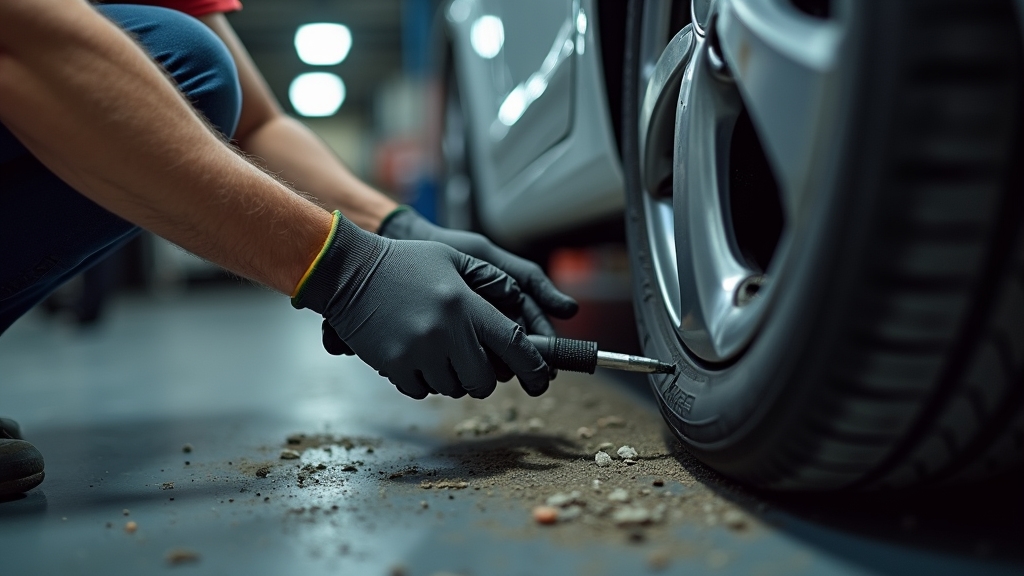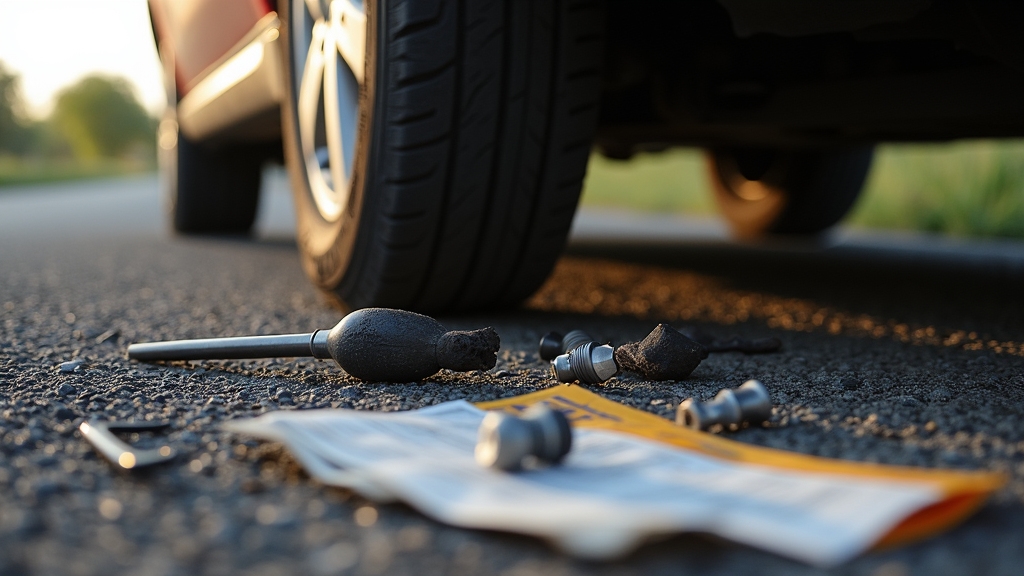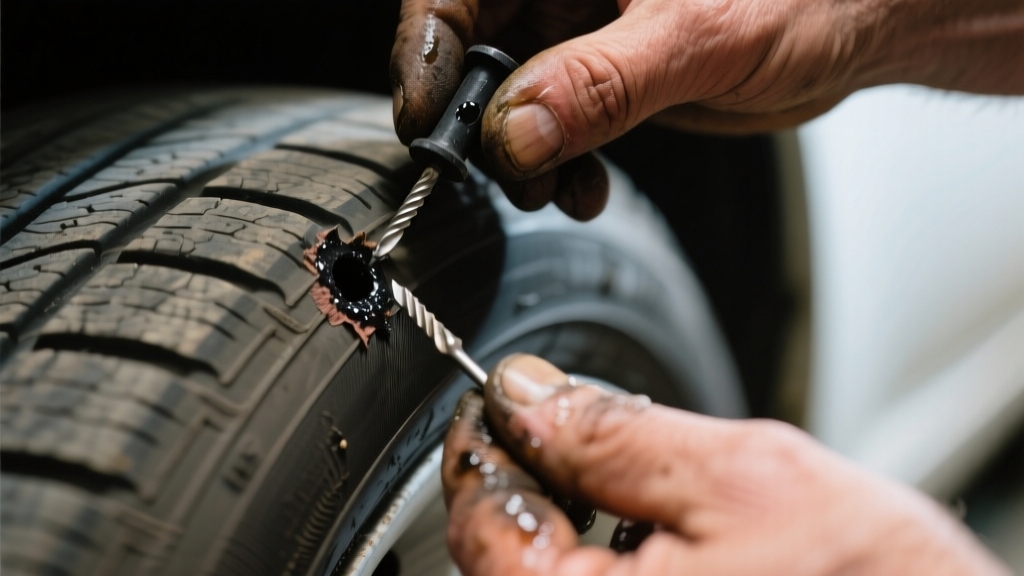You can use tire plugs safely only as a temporary fix for small tread punctures under 6 mm, but they don’t restore your tire’s original structural integrity or guarantee long-term reliability.
Plug-only repairs risk air leaks, internal corrosion, and blowouts, especially if used on sidewalls or large holes. Professionals recommend combining plugs with patches for durable sealing and safety.
Understanding the limitations and proper repair methods is essential to maintain your tire’s performance and reduce risks.
Key Takeaways
- Tire plugs are a temporary fix suitable only for small tread punctures under 6 mm, not for sidewalls or large holes.
- They do not restore original tire strength and can loosen, leading to potential air leaks or blowouts over time.
- Proper installation with a plug combined with an internal patch is necessary for a safe, durable repair.
- DIY tire plugs lack thorough inspection and may miss internal damage, risking structural integrity and safety.
- Professional repairs following industry standards are recommended to ensure long-term tire safety and performance.
How Tire Plugs Work and Their Intended Use?

Although tire plugs serve as a quick fix for punctures, understanding their components and installation process is essential for effective use. You’ll work with sticky, flexible rubber plugs, sometimes combined with cork and adhesive, that seal punctures by filling the hole.
Tire plugs offer a quick puncture fix using sticky rubber, cork, and adhesive to seal holes effectively.
The plug hardens from driving heat, anchoring firmly. First, remove the object causing the puncture, then use a reamer tool to clean and enlarge the hole.
Thread the plug through an insertion tool and push it about two-thirds into the hole, leaving some plug exposed. Pull the tool out quickly, trim excess plug flush, and reinflate the tire.
Tire plugs are intended for small tread punctures, providing temporary mobility until professional repair. They aren’t suitable for sidewalls, large holes, or severe damage.
For long-term protection, regular maintenance recommendations similar to those for vehicle oils can help ensure tire safety and reliability.
Effectiveness of Tire Plugs in Repairing Punctures
You should know that tire plugs offer a temporary fix rather than a permanent solution, as they can loosen and cause leaks over time. Their effectiveness is limited by the puncture size and location, especially since plugs can’t restore the tire’s full structural integrity.
It is important to note that plugs are designed to seal only small holes in the tread area and are not suitable for punctures in the sidewall or shoulder of the tyre. Understanding these limits is vital to evaluating when a plug repair is safe and when a more thorough method is necessary.
Temporary Vs Permanent Fix
When you need a quick roadside repair, tire plugs offer a fast and convenient temporary solution that doesn’t require removing the tire from the rim. They’re ideal for small punctures under 1/8 inch in the tread area and can be installed with basic tools by non-professionals.
Tire plug kits are commonly used for temporary roadside repairs and sealing punctures in tubeless tires, especially in the tread area. However, it is important to consider the durability vs. cost balance when choosing temporary fixes like tire plugs.
However, plugging involves reaming the hole, which damages tire cords and compromises structural integrity. For a permanent fix, tire patches are superior; they require dismounting the tire, allow internal inspection, and provide a durable seal that preserves tire strength.
Patches handle larger or sidewall punctures better and reduce blowout risks by reinforcing the tire from the inside. While plugs are cost-effective and practical short-term, patches are the recommended method for ensuring long-term safety and tire longevity.
Leak Risks Over Time
Since tire plugs provide a quick seal for punctures, they’re often used as a temporary fix rather than a permanent solution. Over time, plugs can loosen or dislodge, leading to gradual or sudden air leaks. Moisture can infiltrate through plug-only repairs, accelerating internal tire degradation and increasing leak risk.
It is important to note that plug-only repairs often do not allow for inspection of the tire’s interior, potentially missing internal damage that compromises safety. Proper maintenance and regular inspection are crucial to ensure the repair’s integrity and prevent unexpected failures.
You should know plugs work best for small tread-area punctures, not sidewall damage where leaks are more probable. Radial rope-type plugs tend to loosen more than mushroom-style plugs, which, if installed correctly, may last longer but still lack manufacturer endorsement.
To minimize leaks and internal corrosion, professionals recommend replacing plugs with combination patch/plug repairs that seal inside and outside the tire, creating a more durable airtight barrier essential for long-term tire safety and performance.
This approach aligns with recommendations emphasizing routine inspection to maintain vehicle reliability and safety.
Structural Integrity Limits
Although tire plugs offer a convenient solution for small punctures, they’ve strict limitations regarding structural repair. You should never rely on plugs for sidewall damage or punctures larger than 6 mm, as these compromise tire strength and increase blowout risk.
Proper assessment of stress impact is crucial to avoid failure under load. Plugs mainly serve as temporary fixes and can’t restore original tire integrity. Consider these critical points:
- Plugs are unsafe for sidewall or bead area punctures due to high stress and flexing.
- Multiple or irregular punctures reduce structural reliability, often mandating tire replacement.
- Plugging enlarges puncture holes, potentially weakening the tire further.
- Industry guidelines restrict plugs to small tread-area punctures under 6 mm for safety compliance.
- Plugs are inserted into the puncture after cleaning and enlarging the hole with a reamer tool.
Always evaluate severity and location before using plugs to maintain your tire’s structural integrity.
Risks Associated With Plug-Only Tire Repairs
When you rely solely on a plug to repair a tire, you risk persistent air leakage due to incomplete sealing. This method also leaves the tire structurally compromised, increasing the chance of failure under stress.
Because a plug is generally considered a temporary solution, industry standards advise having the tire professionally inspected and repaired with a patch or replacement as soon as possible to ensure safety. This structural compromise can lead to a higher likelihood of sudden blowouts, posing serious safety hazards.
ust as selecting the right motor oil with proper viscosity resistance is essential for engine protection, ensuring a complete and reliable tire repair is crucial for vehicle safety.
Air Leakage Risks
Because plug-only tire repairs address the puncture without fully restoring the internal seal, you may experience air leakage over time. This leakage can stem from incomplete sealing, aging tire rubber, temperature fluctuations, or unnoticed valve stem issues.
In particular, temperature fluctuations can cause tire pressure to drop about 1 PSI for every 10°F decrease in ambient temperature, making it harder to detect slow leaks. It is important to consider proper maintenance and use of durability enhancements to help extend the life and performance of tire repairs.
Slow leaks can gradually decrease tire pressure, compromising your vehicle’s handling and safety.
Be aware that air leakage risks include:
- Gradual underinflation causing reduced grip and longer braking distances
- Increased fuel consumption due to higher rolling resistance
- Uneven tire wear accelerating tire replacement costs
- Potential sudden tire failure if leaks remain undetected
To minimize risks, monitor tire pressure frequently after any plug repair and consider professional combination plug/patch methods for more reliable air retention.
Structural Weakness Concerns
While plug-only tire repairs can quickly address punctures, they don’t restore the tire’s structural integrity. Plugs seal the hole but fail to strengthen damaged steel belts and ply cords, leaving internal corrosion risks unmitigated.
Improper repairs have led to significant legal cases, including multi-million dollar verdicts, underscoring the dangers of relying on plug-only fixes. Legal precedents demonstrate the potential consequences of inadequate repair methods.
It is important to consider the trade-offs between quick fixes and long-term safety, much like balancing performance goals with engine protection in automotive upgrades.
Moisture infiltration through the plug accelerates corrosion of steel belts, weakening rubber-to-metal bonds and increasing tread separation likelihood. Unlike patch repairs, plugs don’t provide mechanical reinforcement, making the tire vulnerable under load.
Repairs near the sidewall or shoulder are especially unsafe, as plugs can’t maintain lateral stability in these critical areas. Multiple plugs close together further degrade structural reliability by creating weak points.
Since plug-only fixes are temporary and don’t address underlying damage, professional inspection and combined plug-and-patch repairs are essential to ensure long-term tire safety.
Potential for Blowouts
Although plug-only repairs might seem like a quick solution, they substantially increase the risk of tire blowouts by failing to reinforce the damaged area. Without an inner patch, plugs leave the tire vulnerable to internal moisture ingress, causing corrosion of steel belts and weakening the tire’s structure.
This hidden degradation dramatically raises the chance of sudden failure under pressure. Environmental factors like hot weather contribute significantly to blowout likelihood, making proper repair methods even more critical.
It is important to note that improper tire maintenance and placement, such as using a spare tire incorrectly, can further exacerbate these risks by compromising overall vehicle stability.
You should be aware that plug-only repairs can:
- Leak air about 10% of the time, risking slow leaks or blowouts
- Allow moisture inside, accelerating steel belt corrosion
- Fail to restore full tire integrity or address inner liner damage
- Have been linked to documented blowouts causing accidents and injuries
For your safety, rely on plug-and-patch repairs that restore structural strength and reduce blowout risks.
Legal and Liability Issues Related to Tire Plug Failures
When tire plugs fail, legal and liability issues can quickly become complex, involving manufacturers, repair shops, and technicians alike. You must understand that manufacturers face claims for defective designs and failure to warn, especially when plugs alone cause dangerous conditions.
Courts have recognized that using string plugs without patch seals is a risky repair method that can lead to tire failure. Repair shops and technicians can be liable for improper installation or neglecting to inform you of risks.
Courts have held parties accountable, resulting in multi-million dollar awards. It is important to consider that maintenance and durability of repair methods can significantly affect liability outcomes.
| Party | Liability Basis | Emotional Impact |
|---|---|---|
| Manufacturer | Defective design, failure to warn | Fear of unsafe products |
| Repair Shop | Improper repair, negligence | Distrust in service |
| Technician | Lack of certification, errors | Anxiety over safety |
| Consumer | Injury, loss | Anguish and loss |
Recommended Practices for Safe Tire Repair

Because tire safety depends heavily on proper repair techniques, you must follow recommended practices meticulously to guarantee durability and prevent failure. Begin by fully inspecting the tire off the wheel, probing for hidden damage and cleaning the puncture channel thoroughly with appropriate tools to ensure strong adhesion.
Proper repair is crucial for preventing blowouts and serious crashes, as over 23,000 crashes annually are caused by tire blowouts.
Proper tire repair starts with thorough off-wheel inspection and meticulous cleaning for lasting safety.
Only repair punctures in the tread area under 6mm; avoid repairs on sidewalls or previously repaired spots. Employ the NHTSA-approved combination plug-and-patch method to seal both the puncture channel and inner liner, preventing air leaks and moisture intrusion. This method is recognized as the proper repair technique to prevent accidents and tire failure.
After repair, conduct inflation tests and inspect for leaks to confirm integrity.
- Only repair tread punctures under 6mm diameter
- Remove tire from wheel for complete inspection
- Use combination plug-and-patch repair exclusively
- Perform rigorous post-repair leak and pressure tests
Comparison Between Plug-Only and Plug-and-Patch Repairs
Since tire repair quality directly impacts safety and durability, understanding the differences between plug-only and plug-and-patch methods is essential.
Plug-only repairs fill the external puncture quickly, often roadside, without removing the tire from the rim. However, they don’t address internal damage or reinforce the tire’s structure, making them less reliable long-term and potentially unsafe for highway speeds.
Typically, a plug is a sticky, flexible rubber piece inserted into the hole with adhesive to seal the puncture. Because these repairs do not involve a thorough inspection and cleaning, they may leave hidden damage untreated inside the tire.
In contrast, plug-and-patch repairs require tire removal, allowing you to inspect and clean the inner liner before applying a patch that bonds securely. This combination seals the hole and reinforces the tire from inside, enhancing durability and reducing blowout risk.
Though more complex and time-consuming, plug-and-patch repairs provide a thorough, permanent solution approved for most puncture types, delivering superior safety and longevity compared to plug-only fixes.
Limitations of DIY Tire Plug Kits

Understanding the differences between plug-only and plug-and-patch repairs highlights why DIY tire plug kits come with notable limitations. When you use a plug kit, you face constraints in puncture size, repair location, and durability.
These kits often lack extensive tools to inspect or fix internal tire damage, risking incomplete repairs. Furthermore, improper application can cause leaks or quick failure.
Consider these critical limitations of DIY kits:
- Only suitable for small tread-area punctures, not sidewalls or shoulders
- Temporary fixes that rarely match factory tire integrity
- Difficulty detecting internal damage without removing the tire
- Risk of multiple plugs compromising tire strength
Because proper diagnosis is essential to determine whether a tire can be safely repaired or must be replaced, relying solely on DIY plugs requires caution, as these kits don’t guarantee long-term safety or performance.
Impact of Tire Repairs on Road Safety and Vehicle Performance
Although tire repairs aim to restore safety and performance, improper or inadequate repairs can considerably compromise both. When you rely solely on plug-only repairs, you risk air seepage and internal corrosion, weakening the tire’s structure and increasing the chance of tread separation or blowouts.
This instability affects vehicle handling, steering control, and braking efficiency, ultimately reducing road safety. Underinflation caused by faulty repairs decreases tire-road contact by up to 50%, impairing traction and increasing stopping distances.
In fact, tyre defects contribute to roughly one in five vehicle breakdowns on UK roads and are linked to thousands of injuries and fatalities annually.
To maintain vehicle performance and safety, always guarantee repairs follow professional standards, combining plugs and patches to properly seal the inner liner and preserve tire integrity.
Frequently Asked Questions
Can Tire Plugs Be Used on All Types of Tires?
No, you can’t use tire plugs on all tire types. They work best on tubeless tires with small punctures in the tread area.
Avoid using plugs on tires with inner tubes, run-flat designs, sidewall damage, or heavy-duty commercial tires.
For these, you’ll need specialized repairs like patch-plug combos or professional inspection.
Using plugs improperly risks safety and might void your tire warranty, so always match repair methods to your tire type.
How Long Does a Tire Plug Repair Typically Last?
A properly installed tire plug repair typically lasts 7 to 10 years or about 25,000 miles, depending on your driving conditions.
However, since tires often need replacement within 3 years, plugs usually outlast the tires themselves.
High-speed driving, hot climates, and rough terrain can shorten plug lifespan.
Combining a plug with an internal patch and maintaining proper tire pressure and rotation will extend the repair’s durability effectively.
Are Tire Plugs Compatible With Run-Flat Tires?
You know the saying, “An ounce of prevention is worth a pound of cure.” When it comes to run-flat tires, plugs alone aren’t enough. They’re compatible only for small tread punctures and temporary fixes.
To maintain integrity, you need a combination plug-and-patch repair done professionally after dismounting the tire. Sidewall damage or larger punctures mean replacement.
Do Tire Plugs Affect Tire Balancing or Alignment?
Tire plugs generally don’t affect your tire’s alignment, as alignment relates to wheel angles, not tire integrity.
However, plugs can slightly impact balancing if they add weight or the repair alters tire uniformity, especially near the shoulder.
It’s best to rebalance tires after plugging to prevent vibrations or uneven wear.
Improper mounting, not the plug itself, often causes imbalance.
Regular balancing guarantees smooth handling and prolongs tire life.
Can Tire Plugs Be Removed or Replaced if Needed?
You can absolutely remove or replace tire plugs, but don’t treat it like a casual snack swap—this process demands precision. Use pliers or specialized tools to pull out the plug carefully to avoid damaging the tire.
Then, properly prep the hole by reaming it before inserting a fresh, pliable plug with rubber cement for a tight seal.
Don’t Compromise on Tire Safety
When you spot a puncture, a tire plug might seem like a quick fix, but picture the road ahead, every mile demands reliability. Plug-only repairs can seal small holes temporarily, yet they carry risks that could jeopardize your safety and legal standing.
For lasting security, combine plugs with patches or seek professional service. Don’t gamble with your vehicle’s performance; a properly repaired tire ensures your journey stays smooth, controlled, and safe.




